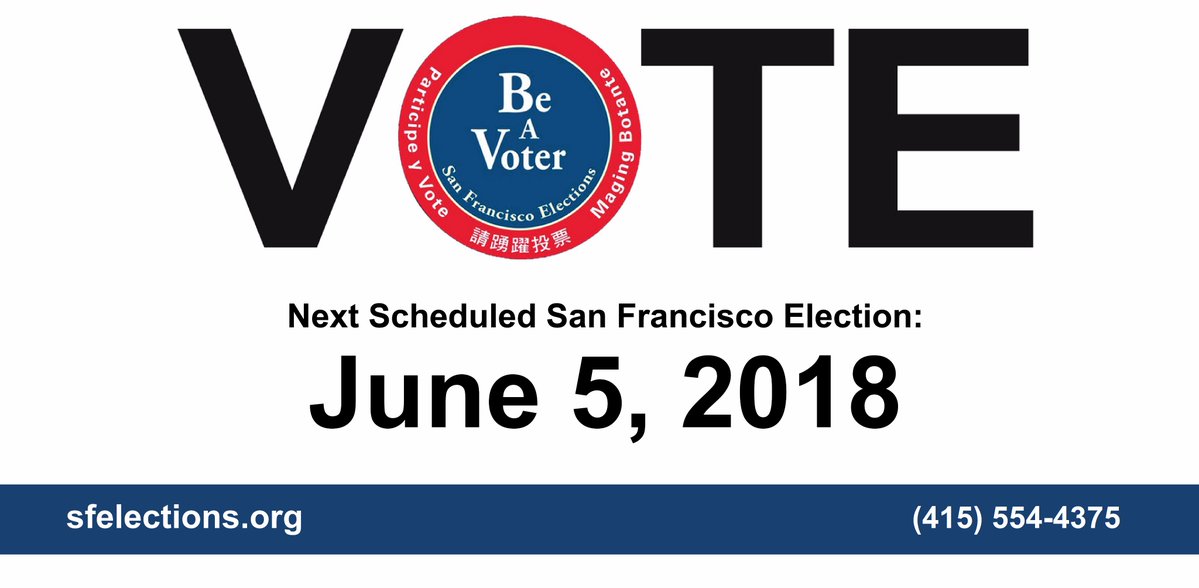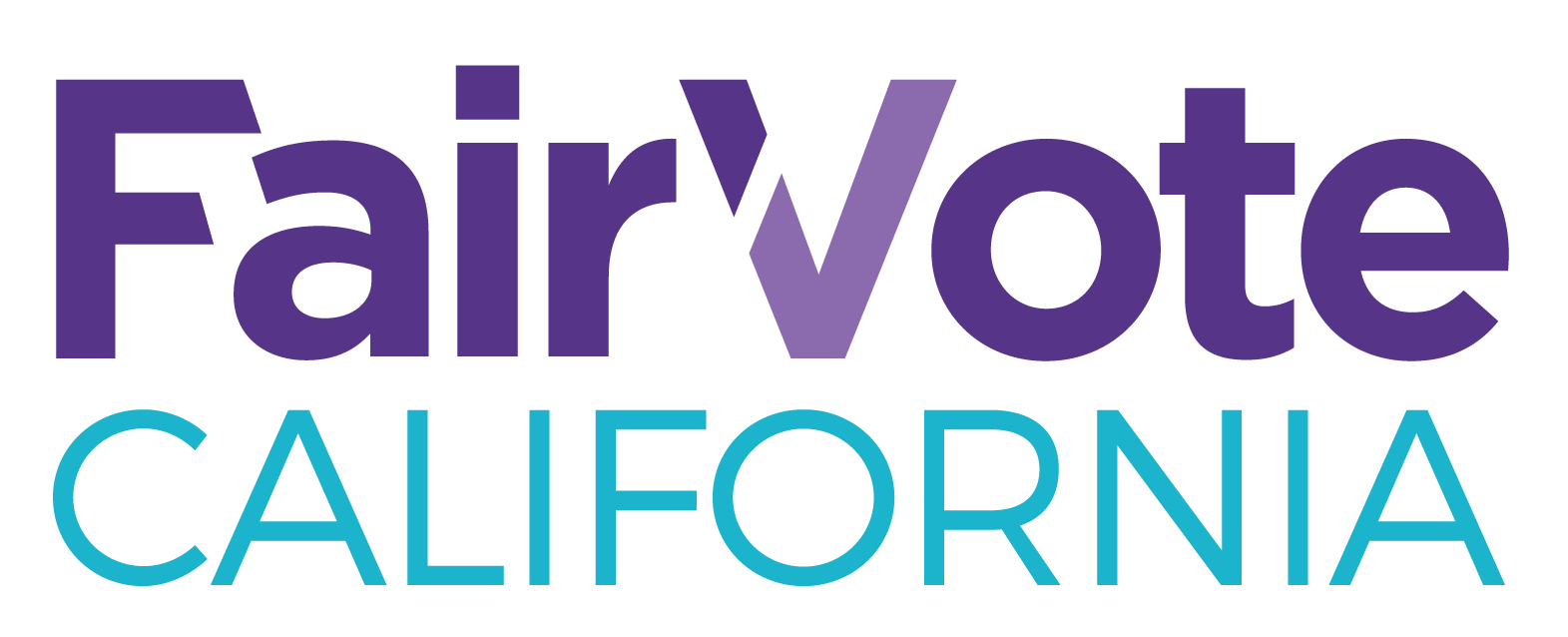 (image source: sfelections.org)
(image source: sfelections.org)
With the sudden passing of Mayor Edwin Lee on Dec. 12, voters in San Francisco will be choosing a new mayor in a special election on June 5, 2018. The winner will be choice in a single ranked choice voting, “instant runoff” election unlike most California vacancies that take far longer to fill over two rounds of voting.
Candidates for the special election will be required to submit their nomination papers by 5 pm on Jan. 9, 2018. The period for candidates to gather voter signatures to reduce the cost of filing nomination papers for the office of mayor is now open; this period ends Tuesday, Dec. 26 at 5pm.
While the field for candidates is not yet clear, we wanted to to provide our supporters with an overview of what to expect.
Why June?
The San Francisco City Charter stipulates that, “[a]ny person filling a vacancy pursuant to subsection (a) or (b) of this Section shall serve until a successor is selected at the next election occurring not less than 120 days after the vacancy, at which time an election shall be held to fill the unexpired term.” San Francisco City Charter Section 13.101.5 (c).
This means, because there is a scheduled election for June 5, 2018 for the District 8 Supervisor seat -- occurring 120 days after the vacancy, the election for a new mayor will be held on June 5th.
This is an unprecedented mayoral race for several reasons: a June election for San Francisco mayor has not been held in at least 100 years, or ever. Author Jon Golinger noted that the the Charter change that requires a vacancy in the Office of Mayor to go on the next possible ballot is relatively new and was not in place back in 1978 after the Moscone assassination, so there was no "special election" then. Prop C in 2001 passed by 75%, amending the Charter to now trigger the Mayoral vacancy election that will be on the June ballot. Golinger explained that, “the Board selected an Interim Mayor to serve out the entire rest of the Mayor's vacant term, however long or short it was. Because of a quirk of timing, that meant that Feinstein had to run almost immediately in November 1979 because that was the end of Moscone's elected term.”
What do we expect turnout to be? Will Ranked Choice Voting (RCV) play a role?
We’ve taken several factors into consideration and we estimate turnout to fall in the range of 175,000 and 231,000 voters in San Francisco, or 34 to 45 percent of voters, a range that is slightly below and slightly above the 2011 mayoral race and historical June primary turnout.
Variables that affect turnout include the level of competitiveness, registration levels, PACs and nationwide and state trends in June municipal elections. While RCV increases the number of voters who elect the winners by eliminating low-turnout runoffs, several factors will be driving turnout relative to previous cycles. This includes:
Timing
The timing of an election is a significant factor in turnout. Most people turnout to vote in November even year general elections. Looking at the last four-election California election cycles in the first round of the "top two" primary in June, turnout of registered voters is on average 28.4 percentage points lower than during the general election in November.
San Francisco turnout also drops significantly during the statewide primary. Looking at the last four June “top two” primary elections in San Francisco, turnout was on an average 37.96 percent, which is 28.5 percentage points lower than the November general election average of 66.8 percent.
Looking at the last four San Francisco mayoral elections, turnout during the odd year/off-cycle mayoral race averages 44.7 percent, a 22.1 percent drop compared to November general elections.
San Francisco holds odd year local elections for mayor to allow voters to focus on municipal issues without the distraction of state or federal elections. It’s worth noting that San Francisco has generally had the highest voter turnout rate among the 22 most populous U.S. cities. However, the combination of general low visibility of these elections and voter fatigue from too many elections means odd year elections have staggering low turnouts.
Since turnout for a November odd year mayoral race has averaged 44.73 percent in the past four election cycles, and turnout for a June "top two" primary has averaged 37.96 percent in the past four election cycles, we anticipate that this June mayoral election will be lower than previous mayoral election races, but higher than the June average.
Competitiveness
Given that most elected officials in city government can run without giving up their seat and given that the winner will become the big favorite to win a full term in 2019, it’s anticipated that many office holders and former electeds will enter the race and make it a very competitive election.
Registration Levels
Based on the latest voter registration numbers from the California Secretary of State, there are 513,401 registered voters in San Francisco. This does not take into account tentative same-day registrants -- beginning in 2018, voters will be to register to vote during the period of 14 days prior to Election Day through and including Election Day. Learn more about the Conditional Voter Registration, here.
Candidate-Affiliated PACs
Campaign finance limits historically kept campaign spending in municipal races low. However, now independent groups can raise and spend unlimited funds, increasing traditional fundraising in the race and using that funding for mailings and TV ads.
While the increase in PAC spending may help increase the visibility of the elections overall and help drive up turnout, it has not been shown that this spending is helpful to the candidates it’s intended to support.
While we have not conducted an in-depth study on the impact of PAC spending in RCV elections, there is anecdotal evidence indicating that the value of PAC spending, which traditionally is used for negative mailings and TV ads, is not as significant under RCV. This is because RCV rewards candidates who can build coalitions and engage in meaningful voter interaction.
Public Financing
San Francisco has a public financing program for candidates for the board of supervisors that was adopted through a ballot measure (Proposition O) in November 2000. In 2006, the program was extended to include mayoral candidates as well. The program was established with the intent to serve several goals: to offer candidates the opportunity to rely more on a neutral source of funding to their campaigns, rather than sources seeking to affect a single or narrow range of issues. It aims to encourage limited spending so that candidates may spend less time fundraising and more time discussing issues important to their constituencies.
In order to qualify, a candidate for mayor who wishes to enroll in public financing must file their paperwork no later than the 70th day before the date of election. The deadline for the June 2018 election will be Tuesday, March 27, 2018. Regulation 1.142-2. For more information, visit the San Francisco Ethics Commission website.
Ranked Choice Voting (RCV) and Voter Turnout
As Professor Richard DeLeon wrote in 2013, “The ranked-choice-voting system facilitates the political representation of San Francisco's diversity by allowing elections to be decided in November, when voter turnout is typically high and more reflective of the city's broader electorate, including racial and ethnic minorities.”
Prior to RCV, many voters did not participate in the second round of voting in December runoffs in San Francisco – the median turnout decline for local runoffs between 2000 and 2003 was 39.5 percent, meaning just three-in-five as many voters turned out in the decisive runoff round.
Under November RCV elections, far more voters participate in the decisive election round. The median percentage of exhausted ballots (ballots that do not count in the final round) in the 24 RCV races needing multiple rounds was 13.2 percent, meaning that 86.8 percent of voters ballots count in the final, decisive, round.
However, because the San Francisco Charter demands that this special election take place in June, we anticipate that June levels of turnout will be a greater predictor of turnout.
How many people do we expect to use their rankings?
It is important to note that the more competitive the race, the more voters rank. Anticipated share of voters ranking in the citywide mayoral and competitive Supervisor races is 75 to 80 percent.
In the 2011 mayoral race in San Francisco where 16 candidates entered the race, of the people voting for mayor, 84.1 percent ranked two or more candidates and 72.80 ranked three. In the 2016 District 11 Supervisor race, 74.6 percent ranked at least two candidates. These rates of ranking demonstrate a very high level of RCV proficiency among voters.
More voters use their rankings when the race is competitive and where there are more than two well known candidates -- just as voter turnout is higher in competitive elections generally. Voters are less likely to rank if they vote for front-running candidates because they would not expect their rankings to come into effect. In general, voters are more likely to rank candidates when they expect the rankings to come into effect, and less likely to do so otherwise.
High rates of ranking consistently occurred across competitive multi-candidate mayoral and supervisor races, including lower-income and highly diverse districts.
| Seat | Ranked at least 2 Candidates | Ranked exactly 2 Candidates | Ranked exactly 3 Candidates |
| District 10 (2010) | 75.6% | 14.5% | 62.1% |
| Mayor (2011) | 84.1% | 11.30% | 72.8% |
| District 5 (2012) | 82.3% | 15% | 67.3% |
| District 7 (2012) | 80.5% | 14.4% | 66.1% |
| District 1 (2016) | 77.6% | 15.5% | 62.10% |
| District 9 (2016) | 75% | 21.9% | 53.10% |
| District 11 (2016) | 74.6% | 13.5% | 61.1% |
Just 0.7 percent of all ballots cast in the large 2011 mayoral race had errors, such as an over-vote or skipped ranking, resulting in a 99.93 percent valid ballot rate.
We anticipate the same trends to emerge in the June 2018 election, and such trends indicate that the voting populace deeply understands the RCV process.
How long will it take before we know who won?
In San Francisco, RCV results will be posted on the night of the election and are updated on a daily basis as provisional and remaining ballots are counted. Any delay in the finality of the election is due to the remaining ballots that need to be counted, but in San Francisco that sometimes can take more than a week.
Continue to visit to learn more about who’s on the ballot and how RCV works in San Francisco. In the mean time, here are some helpful links:
For more information, contact:
Pedro Hernandez
Thank you to FairVote MN for guidance in the creation of this write up.
Updated on December 20, 2017.

Be the first to comment
Sign in with
Facebook Twitter